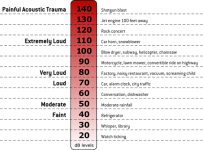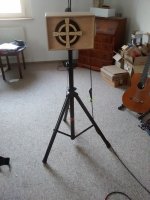would it be loud enough to play for 25 people on the street ?
It depends how far away the people are.
For only 1 W of amplifier power, the B&C 6XT13 is claimed to give an SPL (Sound Pressure Level) of 96 dB at a distance of 1 m.
Every doubling of the distance away from the speaker results in a 6 dB reduction of SPL.
For listeners typically 8 metres away from the speaker the SPL would be 78 dB - loud enough to interfere with conversation.
It would be doubtful that any listeners would want to stand closer than 8 metres because the sound would be too loud!
Attachments
Last edited:
The 6XT13 is a fantastic speaker imho. My amp delivers something between 5 and 10 Watts max. Most of the time the average wattage played is much lower allowing several hours of playing loud. If you really want to enhance the range of your speaker, you should mount it on a speaker stand set to ear height. Helps much more than any bulky high power systems.
+1 for a tool battery pack. If you find you need more time, you could just opt to have a standby pack.
I'm doing something similar using an older hifi center channel speaker, mounted on end on the usual tripod. I think it's going to need more juice than 10w (iirc it's 91db efficient) but that can be accounted for in the power budget.
I'm doing something similar using an older hifi center channel speaker, mounted on end on the usual tripod. I think it's going to need more juice than 10w (iirc it's 91db efficient) but that can be accounted for in the power budget.
That's a good idea. Perhaps I will incorporate rubber straps so it can be strapped to a lamppost.The 6XT13 is a fantastic speaker imho. My amp delivers something between 5 and 10 Watts max. Most of the time the average wattage played is much lower allowing several hours of playing loud. If you really want to enhance the range of your speaker, you should mount it on a speaker stand set to ear height. Helps much more than any bulky high power systems.
Any suggestions on which material to use for the speaker box ? Can i put the amp and battery receiver inside it or should they be housed separately? Is there a cad program for this that everyone is using ? Thanks !
With a size close to a shoebox the wall material is not critical. My personal preference is baltic birch 9mm thick. I do not use a CAD for the enclosure, designing it with pencil and ruler the old way. You can put all together into one box creating a combo. I will shoot some pictures of my combo soon.
Here are the photographs:
Attachments
-
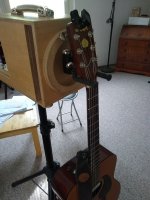 guitar_wardrobe_IMG_20230501_154557799_MP.jpg76.6 KB · Views: 93
guitar_wardrobe_IMG_20230501_154557799_MP.jpg76.6 KB · Views: 93 -
 mounting_hole_IMG_20230501_154618246.jpg42.1 KB · Views: 96
mounting_hole_IMG_20230501_154618246.jpg42.1 KB · Views: 96 -
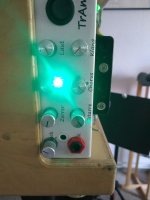 amp_top_IMG_20230501_154658291_MP.jpg53.7 KB · Views: 89
amp_top_IMG_20230501_154658291_MP.jpg53.7 KB · Views: 89 -
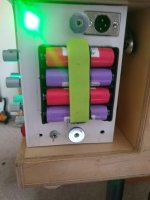 amp_rear_IMG_20230501_154702488_MP.jpg53.7 KB · Views: 87
amp_rear_IMG_20230501_154702488_MP.jpg53.7 KB · Views: 87 -
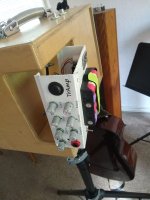 amp_removal_IMG_20230501_154736446.jpg66.2 KB · Views: 99
amp_removal_IMG_20230501_154736446.jpg66.2 KB · Views: 99 -
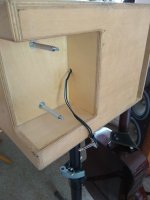 amp_compartment_IMG_20230501_154752967.jpg54.3 KB · Views: 86
amp_compartment_IMG_20230501_154752967.jpg54.3 KB · Views: 86 -
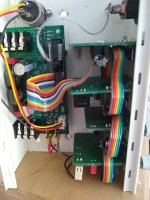 amp_inside_IMG_20230501_154804864.jpg79 KB · Views: 90
amp_inside_IMG_20230501_154804864.jpg79 KB · Views: 90 -
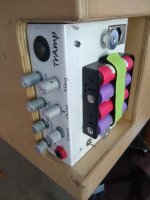 amp_IMG_20230501_154629813.jpg62.3 KB · Views: 79
amp_IMG_20230501_154629813.jpg62.3 KB · Views: 79 -
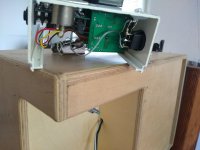 cable_tube_IMG_20230501_154827151_MP.jpg91.5 KB · Views: 90
cable_tube_IMG_20230501_154827151_MP.jpg91.5 KB · Views: 90
Is there a way to determine which size battery I should use? The options seem to be 2Ah and 5Ah. Thanks.
Also, @Galu, can i just bridge (is that what it's called?) each output and power the B&C speaker like that ? Thank you.
Also, @Galu, can i just bridge (is that what it's called?) each output and power the B&C speaker like that ? Thank you.
This TPA3116 based amp has what you ask for, but is dual channel: https://www.ebay.co.uk/itm/204207364697?mkevt=1&mkcid=1&mkrid=710-53481-19255-0&campid=5338757644&toolid=20006&customid=e2a86417734fe13a2fb3c1982a856e94&_trkparms=ispr=1&amdata=enc:1hCqT9fUGT_GXV_rKDu5ZxQ73
Also, can i just bridge (is that what it's called?) each output and power the B&C speaker like that ?
I read that a stereo TPA3116 amp board can't be bridged to drive a single full range speaker.
The amp may also be damaged if used only on one channel with the other channel unconnected.
I believe there are two options if you wish to use this board:
- Use both channels and two full range speakers. You should be able to use slightly less sensitive and less inexpensive drivers because of the doubling of amplifier power (which would result in a 3 dB increase in SPL).
- Use one channel and one full range speaker. You must ground the input of the unused channel using a 1 k ohm; 1/4 W resistor and connect an 8 ohm; 10 W load resistor across the output of the unused channel. With the input grounded, there will be no output signal on that channel. The dummy load is just there to dampen the output filter.
Is there a way to determine which size battery I should use? The options seem to be 2Ah and 5Ah.
Use the largest amp hour (Ah) rating you can.
For example, a 5 Ah battery will supply 5 A for one hour, 2.5 A for 2 hours, 1.25 A for 4 hours, and so on.
The amplifier board in question can deliver up to 10 W at 12 V into a single 8 ohm speaker.
The current consumption from the battery at full output would then be in excess of 10 W/12 V = 0.83 A - let's say 1.0 A.
With a 5 Ah battery, the maximum running time at full output would be 5 Ah/1.0 A = 5 hours (or 2.5 hours for double speaker use).
Last edited:
Thanks! I would like this to be small and lightweight, so I would like to try to stick with one channel and one speaker. Will using that 10w resistor waste a lot of energy and battery life?
I don't know of other amp boards, but is there a mono one that would have bass mid treble and volume that you think might also be suitable? I will wind up going with whatever you say. Thanks !
I don't know of other amp boards, but is there a mono one that would have bass mid treble and volume that you think might also be suitable? I will wind up going with whatever you say. Thanks !
I read that a stereo TPA3116 amp board can't be bridged to drive a single full range speaker.
The amp may also be damaged if used only on one channel with the other channel unconnected.
I believe there are two options if you wish to use this board:
- Use both channels and two full range speakers. You should be able to use slightly less sensitive and less inexpensive drivers because of the doubling of amplifier power (which would result in a 3 dB increase in SPL).
- Use one channel and one full range speaker. You must ground the input of the unused channel using a 1 k ohm; 1/4 W resistor and connect an 8 ohm; 10 W load resistor across the output of the unused channel. With the input grounded, there will be no output signal on that channel. The dummy load is just there to dampen the output filter.
With this calculation you assume an output of full power continuous. This is far from reality. With the hi-efficient TPA xxxx class-D-amps, I play a gig at medium power level with 2Ah-Akkus and loose about 25% of charge. So yes, 2Ah will last several hours in real life.Use the largest amp hour (Ah) rating you can.
For example, a 5 Ah battery will supply 5 A for one hour, 2.5 A for 2 hours, 1.25 A for 4 hours, and so on.
The amplifier board in question can deliver up to 10 W at 12 V into a single 8 ohm speaker.
The current consumption from the battery at full output would then be in excess of 10 W/12 V = 0.83 A - let's say 1.0 A.
With a 5 Ah battery, the maximum running time at full output would be 5 Ah/1.0 A = 5 hours (or 2.5 hours for double speaker use).
With this calculation you assume an output of full power continuous. This is far from reality.
I did indeed assume that and made it clear by saying "at full output".
I am in agreement with you. In practice, the battery will last much longer than my calculations suggest.
Will using that 10w resistor waste a lot of energy and battery life?
I wrote, "With the input grounded, there will be no output signal on that channel. The dummy load is just there to dampen the output filter."
In other words, no power will be developed in the dummy resistor, it won't get hot and it won't shorten the battery life. I think it is rated at 10 W simply as a precaution.
is there a mono one that would have bass mid treble and volume that you think might also be suitable?
I haven't come across one in my searches. Amps with tone controls tend to be stereo units.
In fact it is difficult to calculate discharge time, as this widely varies with you style of playing. Btw I do power my amps with 4x18650 Li-ion cells that are salvaged from old notebook or tool accupacks. Their capacity varies between 1 ~ 2 Ah. They are kept in cheap 4 slot battery holders. To charge them I remove them and put them into a 4slot charger.
Last edited:
Thank you !!!! That makes sense, now that i realize the input is grounded.I wrote, "With the input grounded, there will be no output signal on that channel. The dummy load is just there to dampen the output filter."
In other words, no power will be developed in the dummy resistor, it won't get hot and it won't shorten the battery life. I think it is rated at 10 W simply as a precaution.
I haven't come across one in my searches. Amps with tone controls tend to be stereo units.
They are kept in cheap 4 slot battery holders.
Four x 3.7 V rechargeable Lithium-ion batteries and a four slot 3.7 V Lithium-ion battery charger sounds good to me.
I see such 18650 batteries with a charge capacity of 2.6 Ah.
Thanks @Galu. This project is in part to help improve my 3d design skills, so I might stick with a drill battery just so I have to 3D-print the power mount.
The amplifier you mentioned is proving somewhat hard to track down.
If I were to increase the spec to two inputs, with controls for each, would it be as simple as adding a second amp? I can't quite work out if I would need one giant amp with a ton of knobs, or if i could wire two together somehow. thanks.
The amplifier you mentioned is proving somewhat hard to track down.
If I were to increase the spec to two inputs, with controls for each, would it be as simple as adding a second amp? I can't quite work out if I would need one giant amp with a ton of knobs, or if i could wire two together somehow. thanks.
- Home
- Amplifiers
- Solid State
- Building my first amp, a battery powered busking speaker
